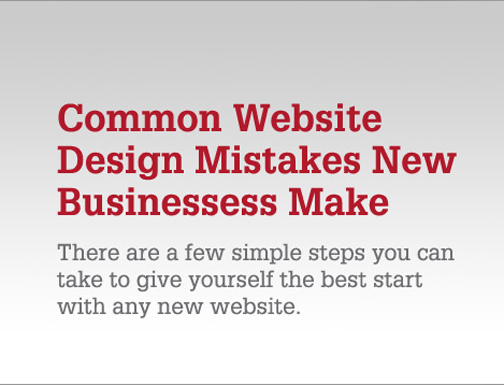Your website is the most obvious and basic marketing tool your business has, so it is vital that it is done right.
A website that is “done right” is one that reaches your target audience, meets your business goals, and answers your users’ questions, not one that you think ‘looks good’. Poorly designed sites translate into instantaneous loss in revenue from potential clients turning away.
Avoid this, and grow your bottom line, by avoiding these all too common errors:
1. Lack of Market Knowledge
Design revolves around your business needs, which it can’t successfully do without a clear understanding of your market. Biggest mistake clients make is they design the website for their own taste and liking, but they are usually NOT the target audience.
2. Getting Flashy or Too Busy
Focus on what counts, not on what will turn users away with a headache. Visitors need to find information easily and clearly, especially if they are using mobile devices. Did you know that if a visitor to your site can’t find what he or she needs within literally 3 seconds, it’s too late? Don’t overdo it.
3. No Clear Call to Action
Your site is clean, clear, and meaningful; now, what’s the point? What are users supposed to do with all of this? Maybe the call to action is to buy a product, or perhaps it’s to fill out a contact form. Regardless, this needs to be in an easy to find, clear location that users will understand and choose. If the content on your website answers the question “What’s my benefit?” your call to action should tell them how to get there. A great website holds the visitor by their hand and directs them where to go next.
4. Over or Under Paying
Do your research to make sure what you build is the right value for your business. Don’t overpay, you’ll never see ROI. Don’t underpay, it will not be effective.
5. Vague or Outdated Content
It is very frustrating as a customer to find outdated or irrelevant information. Avoid this, so that users don’t assume you are behind the game, or even out of business. Reach your current and potential customers, update your blog at least once a week (if you have one), and don’t show off your social media if you have a small following, as this may do more harm than good.
6. Thinking “Everyone is my Target Audience”
A lack of focus leads to a lack of success. Of course, if people outside of your demographic purchase your service or product, you shouldn’t turn them away. But figure out who you should try to accommodate, and focus on them. Trying to please everyone tends to lead to not pleasing anyone. Use the 80/20 rule. Focus on 80% of your target audience.
7. Believing You Can DIY
You may be able to put together your own furniture from Ikea, but building your brand is no coffee table. Your website is the first impression of your brand, and first impressions are everything.
Have you made some of the mistakes above? What mistakes have you seen made?
